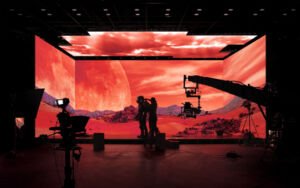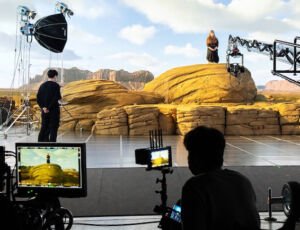LED Screens in the Film and Television Industry

LED Screens in the Film and Television Industry
In recent years, LED screens in the film and television industry have become more and more popular, replacing traditional green screens and providing audiences with a new sense of reality, LED screens or LED walls are large displays made of many LED tiles that emit bright light and can be programmed to display any image or video.
With these screens, it is now possible to project any image onto the screen to create an environment that looks completely real, This is especially useful for creating scenes that require a specific location or background, which can be difficult to achieve when shooting on location.
1.Realistic Immersive Environment:

LED Screens in the Film and Television Industry
One of the main advantages of LED screens is that they provide viewers with a more immersive experience, With traditional green screen, actors often have to imagine their environment and interact with objects that don’t actually exist.
This can be challenging and sometimes results in a final product that lacks realism. However, using LED screens in the film and television industry, filmmakers can create realistic backdrops and environments that actors can interact with in real time, This makes the whole process more engaging for actors and audiences alike.
2. Increase flexibility:
LED screens also offer filmmakers greater flexibility, With green screen, filmmakers have to shoot in separate locations and then add backgrounds in post-production, This can be time-consuming and expensive Using LED screens, filmmakers can shoot everything in one scene, making the process more efficient and cost-effective.
They can also change backgrounds or lighting on the fly, without waiting for post-production, This saves a lot of time and money in post-production work.
3.Improve lighting:

LED Screens in the Film and Television Industry
Another benefit of LED screens is that they offer better lighting options, Traditional green screens require a lot of lighting to produce the desired effect, which can be expensive and time-consuming, With LED screens, lighting can be controlled more precisely, resulting in more realistic and dynamic lighting effects.
4.More control:
LED screens also have environmental benefits, Green screens typically require a lot of materials and resources to build and generate a lot of waste. LED screens, on the other hand, are reusable and require less energy to operate, This makes them a more sustainable option for filmmakers.
Therefore, the trend of using LED screens in sci-fi movies may become more and more common in the future, and this technology can also be applied to other types of film production, bringing more possibilities and creativity to film production.
LED screens are gaining popularity in the film industry, especially for big-budget productions that require complex visual effects and immersive environments, The use of LED screens can create realistic backgrounds and scenery, which can enhance the overall visual quality of the movie.
Overall, the development prospects of LED screens in the film and television industry are optimistic, As the technology continues to improve and become more affordable, we can expect to see more and more filmmakers incorporating LED screens in the film and television industry into their productions, especially for big-budget projects that require a high level of visual effects and immersive environments.
For more information’s about EGYLED projects, Click here.
How do I program my LED display?
The way you program an LED display depends on the specific hardware and programming language. Here are the general steps for your reference:
Understand the hardware:
View the technical specifications and documentation of the LED display to understand how it is connected, communication protocols and supported operations.
Choose a programming language:
Choose a programming language that works for you, common choices include C/C++, Python, etc, Make sure the language you choose is compatible with your hardware and communication protocols.
Set up the development environment:
Install the development environment for the language of choice and configure the correct compiler or interpreter.
Write code:
- Write code to control the LED display using the programming language of your choice, The exact code will vary depending on your hardware and communication protocol.
- Connection: Ensure that the LED display is properly connected to the computer or controller. This may involve using USB, serial ports, networks, etc.
- Initialization: Initialize the communication interface and set necessary parameters based on the requirements of the display.
- Send commands: Use the appropriate command or command sequence to control the display. This may include setting brightness, colors, displaying text or images, and so on.
- Cyclic update: If you want the display to update content in real time, you may need to constantly send update instructions in a loop.
Compile and run:
Compile the code into an executable (if using C/C++) or run the script directly (if using Python), Make sure the hardware is properly connected and the display can receive commands, Please note that the above steps provide general guidance only, and the implementation will vary depending on the hardware and programming language you are using.
Before you start programming, make sure to read and follow the documentation and instructions for your LED display.
When purchasing an LED display control system, the following factors need to be considered?
Display type:
Different types of LED displays require different types of control systems. For example, monochrome and full-color displays require different control systems.
Display effect:
Different display effects require different control systems. For example, a display that requires a dynamic video display needs to support a high refresh rate, while a display that requires a static image can use a control system with a low refresh rate.
Display resolution:
The control system must support the resolution of the display, If the resolution of the control system is not enough to support the resolution of the display, the display effect will be affected.
Control mode:
According to the different control mode, the control system can be divided into synchronous and asynchronous two, The synchronous control system can realize high-definition video playback and real-time data update, while the asynchronous control system is suitable for the display of static images and text.
Use environment:
The control system needs to adapt to the characteristics of the use environment, For example, outdoor displays need to have characteristics such as water, dust and high temperature resistance.
For more information’s about EGYLED projects, Click here.

